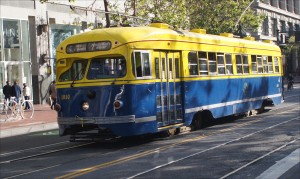William Lind suggests applying the principles of “lean urbanism” to rail mass transit, in effect creating a “lean transit.” Writing in the Center for Public Transportation, Lind is a rare conservative who supports mass transit. But he’s also a realist: He acknowledges that excessive government regulation drives up the cost of mass transit, especially rail, and makes it less competitive with streets and roads.
Writes Lind:
[The Americans with Disabilities Act] has proven the single most expensive, least useful mandate ever leveled on public transit. Serving a small number of disabled people takes a large chunk of transit systems’ budgets, both capital and operating. Many of the special facilities ADA demands of transit systems are seldom if ever used. If something intended to serve the disabled is frequently used, including by people who are not disabled but nonetheless find it helpful, I’m all for it. But millions have been spent entirely uselessly.
ADA is only the beginning of expensive and generally useless over-regulation of transit. One environmental revue of a proposed project makes sense, but often multiple such reviews are required. FRA’s outdated buffer strength requirements have greatly increased the cost of rail transit equipment, with no benefit. A single commuter train accident in California led Congress to mandate positive transit control for all railroads, at a cost in billions and with no technology yet available to do the job. The list is endless.
We need to be able to build streetcar and light rail lines much more cheaply if cities are to afford them. … Lean rail transit, like lean urbanism, requires deregulation, and it also requires an end to fascination with complex, expensive technology that is not needed. The goal should be streetcar lines built for not more than $10 million per mile and light rail built for not more than $20 million per mile.
Liberals love rail mass transit, and then undercut it at every turn. Their solution? Bigger subsidies. No wonder the country is going broke.
— JAB



